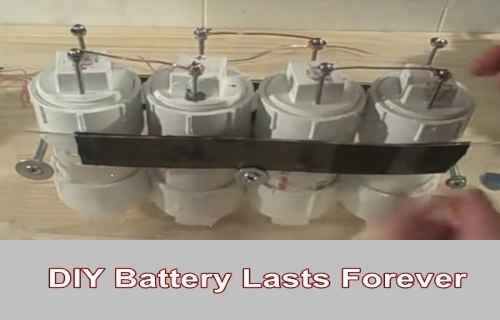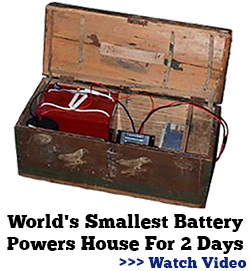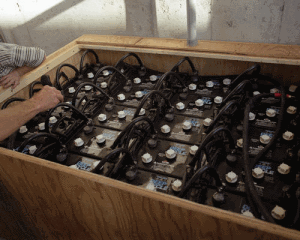Learn how to make a diy battery lasts forever. Called a magnesium or Baghdad battery they are made with a magnesium rod and either a copper coil or a copper rod.
Originally published : By Joshua Krause – Ready Nutrition
When going off the grid, it’s safe to assume that most folks will be relying on solar panels for much of their electrical needs. However, a lack of sunlight can present a few problems for any would-be prepper. If only there was a cheap and simple way to supplement a solar panel array on those cloudy days.
Fortunately, there is such a way, and I’m willing to bet that most of you reading this have never heard of it (I hadn’t until recently). It’s called a Dickens Magnesium Battery after it’s inventor, Stephen Dickens; though the principles behind its function have been around for a very long time. If anything it may be more of a rediscovery, than a completely novel idea.
This device is also called a “Galvanic Cell,” which has been around since the late 1700’s, and possibly even earlier if the theories surrounding the Baghdad Battery are to be believed. It generates small electrical currents by capturing the energy produced by the corrosion of a metal.
In this case, the Dickens battery uses the magnesium as its source of electricity, which many you probably already know if you’ve ever used a fire starter, is a very energy dense material. The design is simple enough that pretty much anyone can make it.
You start out with thick, magnesium rods, which you can buy on Ebay. After that, you’ll need to fasten a metal electrode to the rod with a hose clamp. The metal used for this step is never specified, so feel free to try out a few different metals to see what nets you the best results (more on that in a moment).
After that, you wrap the rod in porous foam, and then coil copper wire around the foam. The idea is to allow water to pass through the foam, but to keep the copper from touching the electrode. Doing so won’t cause anything catastrophic, but your battery will stop producing energy.
After it’s all said and done, it should look like this:

From there, you’ll need a small jar to store this contraption, and you’ll have to puncture holes in the lid to allow the positive and negative contacts to push through. Fill the jar with tap water up to the top of the foam, and close the lid with the contacts exposed. You’ll also need to use something like caulk to seal the holes in the lid, thus keeping the water from evaporating. And that’s it! Your magnesium battery is all done.
But what is it capable of?
Each cell should produce about 1.5 volts, and anywhere from 20mah to 100mah. You’ll notice that the current has a fairly wide range. That’s because this invention hasn’t been around very long, and it’s hard to say what will allow it operate at its optimum efficiency. That’s what I was talking about before with the metal electrode. You’ll have to try a few different metals to see what works best.
Although it doesn’t produce a whole lot of energy, it is pretty cheap, and it will last a reallylong time. Depending on the current you get from it, it may last more than a year. Maybe even longer. It’s hard to say because to my knowledge, nobody has ever completely depleted the magnesium.
And with 1.5 volts, you can connect 8 of these to produce 12 volts of direct current. Coincidentally, that is exactly what you need if you want to connect it to a deep cycle battery, which are typically used to store the energy produced by solar panels. If you manage to get 8 of these producing 100mah of current, you’ll be pumping a steady stream of 1.2 watts of energy, 24 hours a day, for at least 9 months.
At that point, you’ll have to take the battery apart, and scrape the corrosion buildup off the magnesium and the copper wire. And that’s pretty much the only maintenance you’ll have to do. It’s not a lot of energy, but it adds up after a while, and it’ll be able to supplement a small portion of your energy needs when the sun isn’t out. Or if you don’t mind rapidly depleting your magnesium, you can also add salt to the tap water, which will produce more energy.
For a more detailed description of this device, check out the full instructions for its construction, and hopefully you’ll soon be enjoying your new magnesium battery bank.
Choosing the Right Batteries for Your Off Grid Retreat
When most folks first consider living off the grid, they often find themselves in a little over their heads. Self sufficiency is not something to take lightly, and it requires an extensive knowledge base in multiple fields. You have to take responsibility for services that are far easier to outsource in the city, like food production, energy generation, water supplies, and construction. Once you take a step outside of that system, you’re on your own, and you’ll have plenty of challenges ahead of you. If there’s one thing that will make your life easier, it’s a resilient electrical system for your home. And nothing will make your system more convenient or more energy efficient, than a good set of batteries.
Unfortunately, not all batteries are made equal, and the subject of rechargeable batteries can be a little overwhelming at first. Buying the right kind of cell to store your energy is one of the most important decisions you’ll make, especially if you plan on relying on solar energy. Many people make the mistake of thinking they can just hook up some old car batteries to their solar panels and call it day. In reality, if you want the benefits of electricity in your home, you’d better have a basic working knowledge of electricity, and the right batteries for the job.
That means you’ll most likely need a deep cycle battery. Unlike your car battery, these are designed to discharge large amounts of energy without being damaged , and can be recharged many times without any problems. There are three types of deep cycle batteries that are the most popular for people trying to get off the grid. These include :
Flooded/Wet Cell
Flooded batteries are the more traditional choice for most people, and have been around a lot longer than AGM or Gel batteries. They’re significantly cheaper than modern batteries, and can discharge deeper. The only problem is that they need regular maintenance. You’ll periodically have to add distilled water to the battery to keep it running, and they must be stored upright to prevent spilling. Flooded Cells emit corrosive gases so they should be kept in a well ventilated environment, and away from sensitive electronics. Despite these issues, they may be the best choice for your budget and situation. As you’ll soon see, modern isn’t always better.
Gel Cell
Along with AGM, Gel batteries are what’s known as “maintenance free”. They’re sealed in a way that doesn’t required you to continuously add water to them. Rather than a liquid acid, the contents of the battery have the consistency of jello, so they will never leak, and there is very little gassing. Like wet cells, they are built for very deep discharges, but are usually the most expensive batteries on the market. The cost will pay off in the long run though. When you look at the price per discharge/recharge cycle, it ends up being the cheaper option for long term daily use.
AGM
While very similar to Gel cells, AGM batteries have their own pro’s and cons. They’re usually priced between Gel cells and Wet cells, and work better in colder climates than Gel batteries. They’re also maintenance free, with no leakage or gassing, and don’t need to be stored or used in an upright position. The main drawback, is that they are better suited for lower wattage appliances, whereas Gel cells can have very high discharge rates without being damaged. Typically you don’t want draw more than 50 percent of its stored electricity, or it will reduce its lifespan by a large margin.
I would say that, at least initially, most people should purchase a flooded cell battery first. All deep cycle batteries are rather sensitive, and can be easily damaged if they aren’t properly charged or maintained. The difference with wet cells, is your ability to add water to them. While AGM’s and Gel Cells are known as “Maintenance Free” they should also be known as “Maintenance Proof” because there’s no way to open them up and add more fluids. So wet cells have a better ‘margin of error’ so to speak. If you over charge them to the point of cooking off some of its fluids, it’s not the end of the world. You can just add more fluid. Or if you accidentally damage the battery beyond all repair, at least you didn’t spend too much money on it. Make your mistakes on wet cells before moving onto the maintenance free batteries.
You’ll also have to consider the size of the battery you want. The capacity is always measured in amp-hours, and they either come in 6 or 12 volts. Since you’ll want to avoid discharging more than 50 percent of your battery, you’ll have to do the math on how much power you expect to generate and use.
Plus, different batteries will be capable of higher discharge rates. This will be crucial when you get around to hooking your appliances up to your battery, because the wattage rating that’s listed on most appliances is a little misleading. For instance, say you wanted to run an 800 watt coffee maker. When you first turn it on, it’s actually going to run at around 1000 or 1200 watts for a few seconds before it settles into 800 watts. You’ll find the same thing with pretty much all appliances. So if you bought a battery that was only capable of providing the listed wattage on your appliances, you’ll have trouble getting them to start up.
Along with more Amp-hours (Ah), comes more weight. Deep cycle batteries tend to be outrageously heavy. A 100 Ah cell may be the size of an ordinary tool box, but weigh over 60 lbs. If weight is an issue for you, you can buy many smaller batteries and connect them in parallel. This way you can maintain the same voltage, but increase your storage capacity. It should look something like this:
When it comes to charging the batteries, it would be wise to get a smart charger of some kind. Without that technology, it’s very easy to overcharge your batteries and damage them. And once your batteries are ready to be used, you’ll need an inverter to convert the DC power of the battery into the AC power of your appliances. As I mentioned before, since the wattage of your appliance can vary significantly, you’ll need to buy an inverter that’s capable handling the peak wattage of all your appliances.
Finally, if you don’t have a multi-meter you should definitely get one. They’re not very expensive, and they can be handy in many different applications. In this case, you can use it to measure how much electricity your battery is currently storing. 12 volts is actually a bit of a misnomer when it comes to car batteries and deep cycle cells. When a battery is full, it will actually provide 12.6, or even upwards of 13 volts. A completely drained battery will give out around 10.5 volts before it gives up the ghost. It’s kind of like having a bucket full of water and poking a hole in the bottom. The water will come out with less and less force as the bucket empties itself.
Just remember, when you go out to buy your battery, you need something you can rely on above all else. Do your research on the kind of environment you plan on living in, and study up on the different battery options out there. It’s a little bit of a daunting subject at first, but well worth it if you plan on going off the grid.
Books can be your best pre-collapse investment.
Old Time Wisdom ( Timeless Bits of Wisdom on How to Grow Everything Organically, from the Good Old Days When Everyone Did you can prepare yourself for war by moving to the countryside and building a farm, but you must take guns with you, as the hordes of starving will be roaming. Also, even though the elite will have their safe havens and specialist shelters, they must be just as careful during the war as the ordinary civilians, because their shelters can still be compromised.”)
The Lost Ways (Learn the long forgotten secrets that helped our forefathers survive famines,wars,economic crisis and anything else life threw at them)
Survival MD (Best Post Collapse First Aid Survival Guide Ever)
Conquering the coming collapse (Financial advice and preparedness )
Liberty Generator (Build and make your own energy source)
Backyard Liberty (Easy and cheap DIY Aquaponic system to grow your organic and living food bank)
Bullet Proof Home (A Prepper’s Guide in Safeguarding a Home )
Family Self Defense (Best Self Defense Strategies For You And Your Family)
Survive Any Crisis (Best Items To Hoard For A Long Term Crisis)
Survive The End Days (Biggest Cover Up Of Our President)
Joshua Krause was born and raised in the Bay Area. He is a writer and researcher focused on principles of self-sufficiency and liberty at Ready Nutrition. You can follow Joshua’s work at our Facebook page or on his personal Twitter.







Say u were a trillionare and money was no object and u could afford to build a battery from precious metals such as gold and silver. Is there a material that can be used to make the indestructible battery to last as long as the wind blows. A battery made for end of days sort of thing.